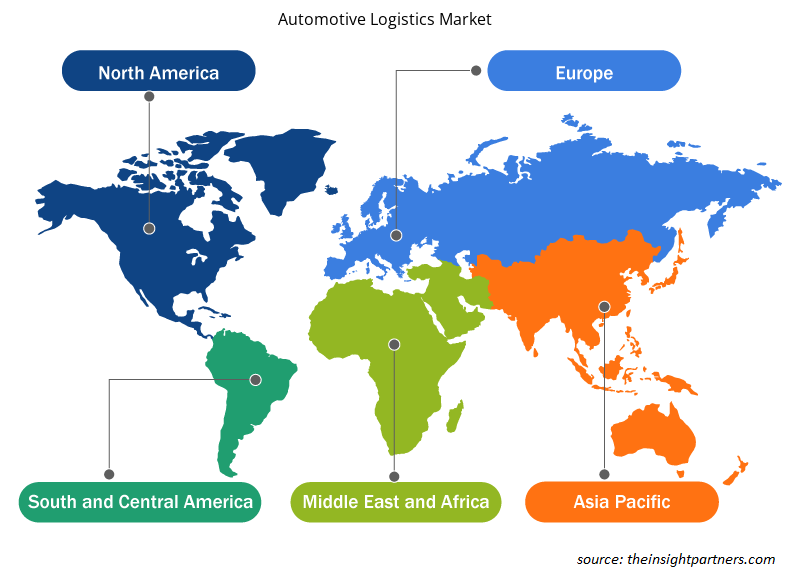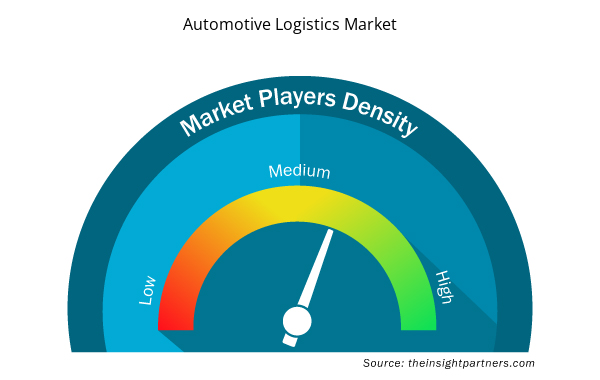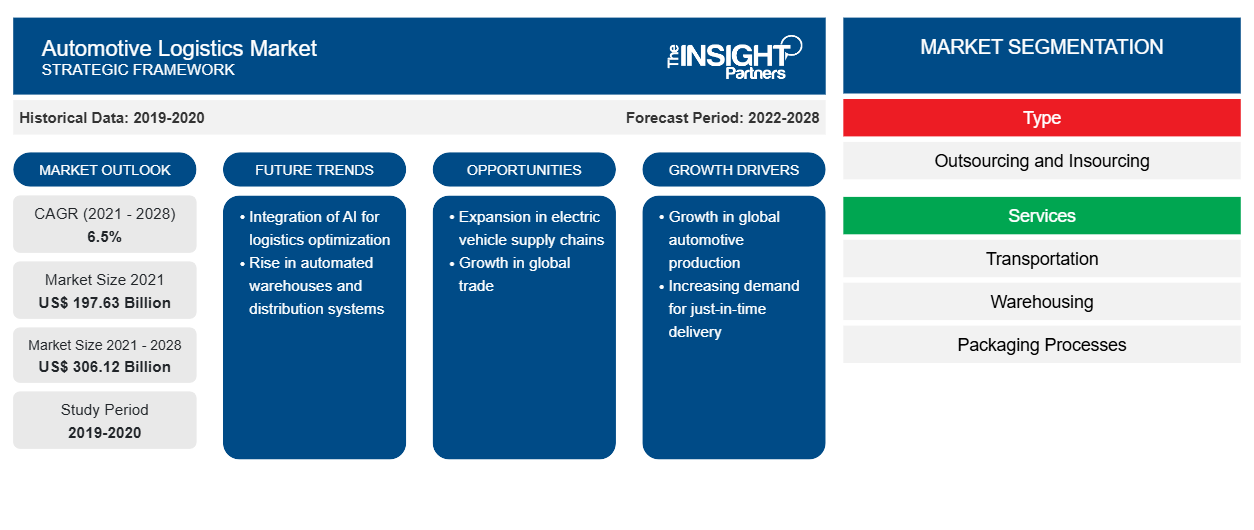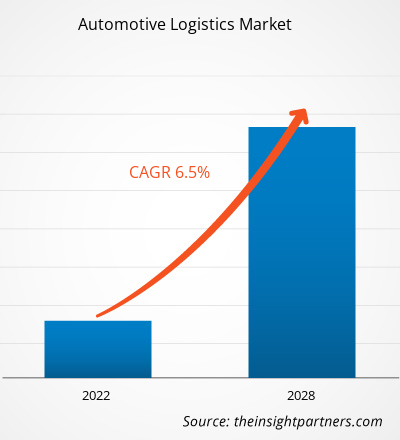[تقرير بحثي] من المتوقع أن ينمو سوق الخدمات اللوجستية للسيارات من 1،97،630.46 مليون دولار أمريكي في عام 2021 إلى 3،06،121.54 مليون دولار أمريكي بحلول عام 2028؛ ومن المتوقع أن ينمو بمعدل نمو سنوي مركب قدره 6.5٪ من عام 2021 إلى عام 2028.
وجهة نظر المحلل:
تلعب سوق الخدمات اللوجستية للسيارات دورًا حاسمًا في الحركة الفعّالة للمركبات وأجزاء السيارات وقطع الغيار في جميع أنحاء الصناعة. وهي تشمل العديد من الشركات المتخصصة في الخدمات اللوجستية للسيارات والمركبات والسيارات، وتقدم خدمات مثل النقل والتخزين وتوزيع منتجات السيارات. شركات الخدمات اللوجستية للسيارات مسؤولة عن إدارة سلاسل التوريد المعقدة المشاركة في صناعة السيارات. فهي تضمن الحركة السلسة للمركبات من مصانع التصنيع إلى وكلاء السيارات أو مباشرة إلى العملاء. تستفيد هذه الشركات من خبرتها في النقل والخدمات اللوجستية لتحسين الطرق وتقليل أوقات التسليم وتعزيز الكفاءة العامة. تركز شركات الخدمات اللوجستية للسيارات أيضًا على نقل وتوزيع أجزاء السيارات وقطع الغيار. وهي تتعامل مع المهمة المعقدة المتمثلة في الحصول على هذه المكونات وتخزينها وتسليمها إلى مصانع التجميع أو مراكز الإصلاح. من خلال الاستفادة من الأنظمة والتقنيات المتخصصة، تعمل شركات الخدمات اللوجستية لأجزاء السيارات على تبسيط تدفق المخزون، مما يضمن توفر الأجزاء المناسبة في الوقت المناسب.
تعتبر الخدمات اللوجستية عنصرًا أساسيًا في قطاع السيارات والنقل الذي يحافظ على سير الصناعة بسلاسة. وهي تشمل أنشطة مختلفة، بما في ذلك تخزين السيارات وإدارة المخزون والتعبئة والتغليف والخدمات اللوجستية العكسية. تعمل إدارة الخدمات اللوجستية للسيارات الفعّالة على تقليل التكاليف وتحسين رضا العملاء وزيادة الكفاءة التشغيلية. كما يوفر سوق الخدمات اللوجستية للسيارات فرص عمل متنوعة، بما في ذلك وظائف الخدمات اللوجستية للسيارات. تتضمن هذه الأدوار تنسيق والإشراف على نقل وتسليم المركبات أو أجزاء السيارات. من إدارة العمليات اللوجستية إلى تحسين عمليات سلسلة التوريد، يلعب المحترفون في هذا المجال دورًا محوريًا في ضمان الحركة الآمنة وفي الوقت المناسب لمنتجات السيارات. تشهد سوق الخدمات اللوجستية لقطع غيار السيارات العالمية نموًا كبيرًا بسبب الطلب المتزايد على إدارة سلسلة التوريد الفعّالة والتسليم في الوقت المناسب لقطع الغيار. يقدم مستشار الخدمات اللوجستية الخبرة والحلول لتحسين عملية الخدمات اللوجستية لقطع غيار السيارات، وتقليل التكاليف وتحسين رضا العملاء. تضمن الخدمات اللوجستية لقطع غيار السيارات التدفق السلس لقطع الغيار عبر سلسلة التوريد. في المقابل، تركز قطع غيار الخدمات اللوجستية للسيارات على نقل وتوزيع مكونات السيارات بكفاءة لتلبية متطلبات السوق.
نظرة عامة على السوق:
تُعرف عملية ترتيب ونقل الموارد، مثل الآلات والمخزون والإمدادات المتعلقة بالسيارات الجاهزة وقطع غيار السيارات، من منطقة واحدة إلى الموقع المقصود باسم الخدمات اللوجستية للسيارات. لتلبية متطلبات العملاء، فهي التحكم في تدفق السلع من نقطة المنشأ إلى نقطة الاستهلاك. إن إدارة العمليات اليومية لإنتاج السلع والخدمات المكتملة للشركة هي التركيز الرئيسي لإدارة الخدمات اللوجستية. هذا النوع من الإدارة يحرك الأشياء بكفاءة وفعالية للأمام والخلف وإلى التخزين. أصبح الطلب على خدمة لوجستية فعالة ومخصصة سمة مميزة بين مقدمي الخدمات اللوجستية المختلفة وهو أمر ضروري للحفاظ على المنافسة في السوق. كما تقوم شركات الخدمات اللوجستية بدمج التقنيات المبتكرة مثل البيانات الضخمة وإنترنت الأشياء ( IoT ) والسفن المرتبطة لتحسين نظام إدارة سلسلة التوريد الخاصة بها.
تساعد هذه التقنيات في توفير تكاليف العمالة والتخلص من تأخير الشحن. يؤثر الطلب الذي تم إنشاؤه لصناعة السيارات بشكل كبير على توسع السوق. نظرًا لزيادة القدرة الشرائية وارتفاع مستويات المعيشة في جميع أنحاء العالم، من المتوقع أن يتطور قطاع السيارات بشكل كبير في السنوات القادمة. ومن المتوقع أن تعمل الزيادة في مبيعات السيارات في الدول الناشئة بسبب هذا التحول في نمط الحياة على تعزيز نمو السوق خلال فترة التنبؤ. بالإضافة إلى ذلك، من المتوقع أن تعمل الحاجة إلى قطع غيار المركبات للوجستيات الكبيرة للسيارات الموجودة على الطريق على تغذية السوق خلال فترة التنبؤ.
قم بتخصيص هذا التقرير ليناسب متطلباتك
ستحصل على تخصيص لأي تقرير - مجانًا - بما في ذلك أجزاء من هذا التقرير، أو تحليل على مستوى الدولة، وحزمة بيانات Excel، بالإضافة إلى الاستفادة من العروض والخصومات الرائعة للشركات الناشئة والجامعات
- احصل على أهم اتجاهات السوق الرئيسية لهذا التقرير.ستتضمن هذه العينة المجانية تحليلاً للبيانات، بدءًا من اتجاهات السوق وحتى التقديرات والتوقعات.
محرك السوق:
توسع صناعة التجارة الإلكترونية عالميًا لتعزيز نمو سوق الخدمات اللوجستية للسيارات
لقد برز التوسع السريع لصناعة التجارة الإلكترونية كمحرك مهم لنمو السوق في قطاع الخدمات اللوجستية للسيارات. ومع تحول المستهلكين بشكل متزايد إلى المنصات عبر الإنترنت لشراء المركبات وقطع غيار السيارات وقطع الغيار، ارتفع الطلب على حلول الخدمات اللوجستية الفعّالة بشكل كبير. وقد أثر هذا الارتفاع في أنشطة التجارة الإلكترونية بشكل مباشر على شركات الخدمات اللوجستية للسيارات والسيارات، مما أدى إلى تحويل طريقة عملها وتوسيع إمكاناتها السوقية. لقد خلقت التجارة الإلكترونية طرقًا جديدة لمبيعات السيارات، حيث أصبح المستهلكون الآن قادرين على تصفح وشراء المركبات عبر الإنترنت. وقد استلزم هذا الاتجاه تطوير خدمات لوجستية متخصصة مصممة للتعامل مع نقل وتسليم المركبات التي تم شراؤها عبر الإنترنت. وقد تدخلت شركات الخدمات اللوجستية للسيارات لسد الفجوة بين عمليات الشراء عبر الإنترنت والتسليم المادي، مما يضمن نقل المركبات بأمان وكفاءة إلى مواقع المشترين.
وعلاوة على ذلك، أدى ازدهار التجارة الإلكترونية إلى تغذية الطلب على قطع غيار السيارات وقطع الغيار من خلال الأسواق عبر الإنترنت. والآن أصبح لدى العملاء راحة طلب مكونات وقطع غيار محددة من راحة منازلهم. وقد أدى هذا التحول إلى ظهور خدمات لوجستية لقطع غيار السيارات متخصصة في إدارة تخزين هذه العناصر وتعبئتها وتوصيلها. ويستفيد مزودو الخدمات اللوجستية هؤلاء من خبرتهم لتبسيط سلسلة التوريد، وضمان تسليم الأجزاء المناسبة للعملاء على الفور. كما دفع توسع صناعة التجارة الإلكترونية شركات الخدمات اللوجستية للسيارات إلى تبني تقنيات مبتكرة وحلول لوجستية للسيارات لتعزيز عملياتها.
أصبحت أنظمة التتبع المتقدمة وبرامج تحسين المسار وأدوات إدارة المخزون في الوقت الفعلي ضرورية لتلبية متطلبات عملاء التجارة الإلكترونية. من خلال الاستفادة من هذه التقنيات، يمكن لشركات لوجستيات السيارات والسيارات تقديم خدمات فعالة وشفافة، مما يضمن التسليم في الوقت المناسب ورضا العملاء العالي. علاوة على ذلك، فتح نمو صناعة التجارة الإلكترونية فرص عمل جديدة في قطاع لوجستيات السيارات. أصبحت وظائف لوجستيات السيارات، وخاصة في مجال تنفيذ التجارة الإلكترونية، ذات أهمية متزايدة. هناك طلب كبير على المهنيين ذوي الخبرة في إدارة الطلبات عبر الإنترنت وتنسيق الشحنات وتحسين العمليات اللوجستية. أدى هذا الاتجاه إلى توسيع القوى العاملة في سوق لوجستيات السيارات، مما ساهم في نموها الإجمالي.
التحليل القطاعي:
اعتمادًا على النوع، ينقسم سوق الخدمات اللوجستية للسيارات إلى:
- الاستعانة بمصادر خارجية
- الاستعانة بمصادر داخلية
استحوذ قطاع التعهيد الداخلي على أكبر حصة من السوق في عام 2020، في حين من المتوقع أن يسجل قطاع التعهيد الخارجي أعلى معدل نمو سنوي مركب في السوق خلال فترة التوقعات. ويستحوذ قطاع التعهيد الداخلي في سوق الخدمات اللوجستية للسيارات على أكبر حصة. وذلك لأن شركات السيارات والمصنعين يختارون إدارة عملياتهم اللوجستية داخليًا، مما يتيح لهم قدرًا أكبر من التحكم والرؤية والاستفادة من الموارد الحالية. يتيح التعهيد الداخلي التخصيص والتمييز والوصول إلى البيانات والتحليلات في الوقت الفعلي. وفي حين لا يزال التعهيد الخارجي يلعب دورًا، فإن هيمنة التعهيد الداخلي تدفع النمو الإجمالي لسوق الخدمات اللوجستية للسيارات.
التحليل الإقليمي:
بلغت قيمة سوق الخدمات اللوجستية للسيارات في منطقة آسيا والمحيط الهادئ 86.77 مليار دولار أمريكي في عام 2021 ومن المتوقع أن تصل إلى 142.34 مليار دولار أمريكي بحلول عام 2028؛ ومن المتوقع أن تنمو بمعدل نمو سنوي مركب قدره 7.3٪ خلال الفترة المتوقعة. وقد رسخت منطقة آسيا والمحيط الهادئ هيمنتها في سوق الخدمات اللوجستية للسيارات، حيث ظهرت باعتبارها القطاع الجغرافي الرائد. تساهم العديد من العوامل الرئيسية في هيمنة المنطقة على السوق، بما في ذلك صناعة تصنيع السيارات القوية، والنمو الاقتصادي السريع، وقاعدة المستهلكين المتوسعة.
أولاً، تعد منطقة آسيا والمحيط الهادئ موطنًا لبعض أكبر مصنعي السيارات ومراكز الإنتاج في العالم. وقد شهدت دول مثل الصين واليابان وكوريا الجنوبية والهند نموًا كبيرًا في قطاعات السيارات لديها، مما جذب شركات صناعة السيارات العالمية وعزز إنشاء مرافق تصنيع واسعة النطاق. يولد هذا الوجود القوي لتصنيع السيارات طلبًا كبيرًا على خدمات لوجستية السيارات، مما يدفع نمو السوق في المنطقة. ثانيًا، أدى النمو الاقتصادي السريع الملحوظ في منطقة آسيا والمحيط الهادئ إلى زيادة في الاستهلاك المحلي وزيادة الطلب على المركبات. ومع ارتفاع الدخول المتاحة في دول المنطقة، كانت هناك زيادة كبيرة في شراء السيارات والمركبات الأخرى. يترجم هذا النمو في ملكية المركبات بشكل مباشر إلى ارتفاع الطلب على خدمات لوجستية السيارات، بما في ذلك النقل والتخزين وتوزيع المركبات وقطع غيار السيارات.
بالإضافة إلى ذلك، تلعب قاعدة المستهلكين المتوسعة في منطقة آسيا والمحيط الهادئ دورًا محوريًا في هيمنة السوق. مع عدد سكان يتجاوز 4.6 مليار نسمة، تقدم المنطقة قاعدة عملاء واسعة لمصنعي وموردي السيارات. لقد خلقت الطبقة المتوسطة الصاعدة والتحضر المتزايد في دول مثل الصين والهند سوقًا كبيرًا للسيارات. يتطلب هذا النمو في الطلب على المركبات خدمات لوجستية فعالة وموثوقة للسيارات لضمان التسليم في الوقت المناسب وتلبية توقعات المستهلكين. علاوة على ذلك، تبنت منطقة آسيا والمحيط الهادئ بشكل استباقي التقنيات المتقدمة والرقمنة في العمليات اللوجستية. مع صعود التجارة الإلكترونية ودمج الحلول القائمة على التكنولوجيا، مثل أنظمة إدارة سلسلة التوريد والتتبع في الوقت الفعلي وتحليلات البيانات، عززت المنطقة كفاءة وفعالية خدماتها اللوجستية للسيارات.
ويعمل هذا التقدم التكنولوجي على تعزيز هيمنة منطقة آسيا والمحيط الهادئ على السوق. كما تساهم المبادرات الحكومية والاستثمارات في تطوير البنية الأساسية في هيمنة المنطقة على السوق. وقد استثمرت بلدان منطقة آسيا والمحيط الهادئ بنشاط في البنية الأساسية للنقل، بما في ذلك شبكات الطرق والموانئ وأنظمة السكك الحديدية، لدعم صناعة السيارات المتنامية. وتسهل هذه التطورات في البنية الأساسية النقل السلس والعمليات اللوجستية الفعّالة، مما يجعل المنطقة مركزًا جذابًا لتصنيع السيارات وأنشطة الخدمات اللوجستية.
تتمتع سوق الخدمات اللوجستية للسيارات في أمريكا الشمالية بحضور قوي في الصناعة وبنية تحتية لوجستية متقدمة، وهي مهمة في سوق الخدمات اللوجستية للسيارات. في أمريكا الشمالية، تستفيد شركات السيارات والخدمات اللوجستية للسيارات من قطاع تصنيع السيارات الراسخ وشبكات النقل القوية والتركيز على التقدم التكنولوجي. تعد أمريكا الشمالية موطنًا لشركات تصنيع السيارات الكبرى وسوق سيارات مزدهرة، مع لاعبين رئيسيين في الولايات المتحدة والمكسيك وكندا. تولد هذه الشركات طلبًا كبيرًا على خدمات الخدمات اللوجستية للسيارات، بما في ذلك النقل والتخزين وتوزيع المركبات وقطع غيار السيارات.
إن وجود شركات تصنيع وتوريد السيارات المشهورة يدفع نمو سوق الخدمات اللوجستية للسيارات في المنطقة. وفيما يتعلق بالبنية التحتية للنقل، تفتخر أمريكا الشمالية بشبكات طرق واسعة وأنظمة سكك حديدية وموانئ متصلة بشكل جيد. تسهل هذه البنية التحتية الحركة والتوزيع الفعال للمركبات وأجزاء السيارات، مما يسمح لشركات الخدمات اللوجستية للسيارات بتحسين العمليات اللوجستية. تضمن البنية التحتية للنقل في المنطقة عمليات التسليم في الوقت المناسب، وتمكن العمليات الفعالة من حيث التكلفة، وتدعم النمو الإجمالي لسوق الخدمات اللوجستية للسيارات. علاوة على ذلك، تؤكد أمريكا الشمالية على التقدم التكنولوجي في صناعة الخدمات اللوجستية، مع التركيز على الرقمنة والأتمتة. تستفيد شركات الخدمات اللوجستية للسيارات في المنطقة من التقنيات المتطورة مثل أنظمة إدارة سلسلة التوريد والتتبع في الوقت الفعلي وتحليلات البيانات لتعزيز الكفاءة التشغيلية وتوفير خدمة عملاء متفوقة. من خلال تبني هذه الحلول المتقدمة، تعمل شركات الخدمات اللوجستية للسيارات في أمريكا الشمالية على تحسين إدارة المخزون وتبسيط العمليات وتحسين رؤية سلسلة التوريد بشكل عام.
بالإضافة إلى ذلك، شهدت أمريكا الشمالية الأهمية المتزايدة للتجارة الإلكترونية في صناعة السيارات. وقد أدى ظهور المنصات عبر الإنترنت لبيع المركبات وتوزيع أجزاء السيارات إلى تحفيز الطلب على الخدمات اللوجستية المتخصصة. واستجابت شركات الخدمات اللوجستية للسيارات في أمريكا الشمالية لهذا الاتجاه من خلال تطوير حلول مخصصة لنقل وتسليم المركبات وأجزاء السيارات التي تم شراؤها من خلال منصات التجارة الإلكترونية. ويعزز هذا التركيز على الخدمات اللوجستية للتجارة الإلكترونية نمو سوق الخدمات اللوجستية للسيارات في المنطقة. كما تساهم السياسات والمبادرات الحكومية في تقديم رؤى إقليمية حول سوق الخدمات اللوجستية للسيارات في أمريكا الشمالية. وقد نفذت حكومات الولايات المتحدة والمكسيك وكندا تدابير لدعم صناعة السيارات وتعزيز البنية التحتية اللوجستية. وتشمل هذه التدابير الاستثمارات في البنية التحتية للنقل، وتعزيز اتفاقيات التجارة عبر الحدود، وتعزيز بيئة مواتية لتصنيع السيارات وعمليات الخدمات اللوجستية.
رؤى إقليمية حول سوق الخدمات اللوجستية للسيارات
لقد قام المحللون في Insight Partners بشرح الاتجاهات والعوامل الإقليمية المؤثرة على سوق الخدمات اللوجستية للسيارات طوال فترة التوقعات بشكل شامل. يناقش هذا القسم أيضًا قطاعات سوق الخدمات اللوجستية للسيارات والجغرافيا في جميع أنحاء أمريكا الشمالية وأوروبا ومنطقة آسيا والمحيط الهادئ والشرق الأوسط وأفريقيا وأمريكا الجنوبية والوسطى.

- احصل على البيانات الإقليمية المحددة لسوق الخدمات اللوجستية للسيارات
نطاق تقرير سوق الخدمات اللوجستية للسيارات
| سمة التقرير | تفاصيل |
|---|---|
| حجم السوق في عام 2021 | 197.63 مليار دولار أمريكي |
| حجم السوق بحلول عام 2028 | 306.12 مليار دولار أمريكي |
| معدل النمو السنوي المركب العالمي (2021 - 2028) | 6.5% |
| البيانات التاريخية | 2019-2020 |
| فترة التنبؤ | 2022-2028 |
| القطاعات المغطاة | حسب النوع
|
| المناطق والدول المغطاة | أمريكا الشمالية
|
| قادة السوق وملفات تعريف الشركات الرئيسية |
|
كثافة اللاعبين في السوق: فهم تأثيرها على ديناميكيات الأعمال
يشهد سوق الخدمات اللوجستية للسيارات نموًا سريعًا، مدفوعًا بالطلب المتزايد من المستخدم النهائي بسبب عوامل مثل تفضيلات المستهلكين المتطورة والتقدم التكنولوجي والوعي المتزايد بفوائد المنتج. ومع ارتفاع الطلب، تعمل الشركات على توسيع عروضها والابتكار لتلبية احتياجات المستهلكين والاستفادة من الاتجاهات الناشئة، مما يؤدي إلى زيادة نمو السوق.
تشير كثافة اللاعبين في السوق إلى توزيع الشركات أو المؤسسات العاملة في سوق أو صناعة معينة. وهي تشير إلى عدد المنافسين (اللاعبين في السوق) الموجودين في مساحة سوق معينة نسبة إلى حجمها أو قيمتها السوقية الإجمالية.
الشركات الرئيسية العاملة في سوق الخدمات اللوجستية للسيارات هي:
- شركة سيڤا للخدمات اللوجستية
- دي بي شينكر
- دي إس في أيه/إس
- DHL International GmbH (مجموعة Deutsche Post DHL)
- جيوديس
إخلاء المسؤولية : الشركات المذكورة أعلاه ليست مرتبة بأي ترتيب معين.

- احصل على نظرة عامة على أهم اللاعبين الرئيسيين في سوق الخدمات اللوجستية للسيارات
تحليل اللاعب الرئيسي:
يتكون تحليل سوق الخدمات اللوجستية للسيارات من لاعبين مثل CEVA Logistics AG؛ DB Schenker؛ DSV A/S؛ DHL International GmbH (Deutsche Post DHL Group)؛ GEODIS؛ Kuehne + Nagel Management AG؛ Nippon Express Co.، Ltd.؛ Ryder System، Inc.؛ XPO Logistics، Inc.؛ و United Parcel Service of America، Inc. ومن بين اللاعبين في الخدمات اللوجستية للسيارات، تعد CEVA Logistics AG و Nippon Express Co.، Ltd. من بين اللاعبين الأوائل نظرًا لمجموعة المنتجات المتنوعة المقدمة.
التطورات الأخيرة:
تتبنى الشركات العاملة في سوق الخدمات اللوجستية للسيارات بشكل كبير الاستراتيجيات العضوية وغير العضوية مثل عمليات الدمج والاستحواذ. وفيما يلي بعض التطورات الرئيسية الأخيرة في السوق:
- في عام 2023، حصلت ولاية ميشيغان على 13 مليون دولار لتمويل تطوير مركز شحن جديد لشاحنات نقل السيارات الكهربائية، بالشراكة مع شركة Daimler Truck North America وشركة DTE Energy.
- التحليل التاريخي (سنتان)، السنة الأساسية، التوقعات (7 سنوات) مع معدل النمو السنوي المركب
- تحليل PEST و SWOT
- حجم السوق والقيمة / الحجم - عالميًا وإقليميًا وقطريًا
- الصناعة والمنافسة
- مجموعة بيانات Excel



Report Coverage
Revenue forecast, Company Analysis, Industry landscape, Growth factors, and Trends

Segment Covered
This text is related
to segments covered.

Regional Scope
North America, Europe, Asia Pacific, Middle East & Africa, South & Central America

Country Scope
This text is related
to country scope.
الأسئلة الشائعة
The transportation services segment led the automotive logistics market with a share of more than 50% in 2020.
Asia Pacific dominated the automotive logistics market in 2020 with a share of more than 40% and is expected to maintain its leading position by 2028.
The major companies in Automotive Logistics includes XPO Logistics, Inc.; United Parcel Service of America; DHL International GmbH (Deutsche Post DHL Group); Ryder System, Inc.; and Kuehne + Nagel International AG.
The insourcing segment led the automotive logistics market with a share of more than 75% in 2020 and its anticipated to dominate over the forecast period. The advantages of insourcing logistics include a complete visibility of the supply chain operations of shipments. Different initiatives have been undertaken by various companies to propel the proliferation of automotive logistics. For instance, in 2017, McLaren Automotive aims to insource the production of carbon fibre chassis by 2020.
The significant proliferation of vehicle manufacturing, within-country sales, and export of vehicles in China is a prominent part of the Belt and Road strategy. China, being the most significant vehicle manufacturing country in the APAC region, produced 27.8 million vehicles in 2018, which showcases the demand for automotive logistics in the country. The rising demand for Chinese manufactured vehicles in these countries is increasingly pressuring Chinese automakers to partner with logistics companies. This factor is posing a significant business growth opportunity for Chinese logistics companies and international logistics partners, thereby, is anticipated to boost the automotive logistics market in the coming years.
The global automotive sector is experiencing significant demand for vehicles, pressuring the vehicle manufacturers to deliver the required number of vehicles. However, the performance of the vehicle manufacturers increased in 2018 and 2019. The surge in demand for passenger and commercial automobiles across the globe is majorly driven by the increase in disposable income and growth in manufacturing units in developed and developing countries. In European and North American countries, an increase in demand for commercial vehicles is witnessed, which led the European and North American countries to experience a growth in the number of commercial vehicle manufacturing units or assembly units.
The List of Companies - Automotive Logistics Market
- CEVA Logistics AG
- DB Schenker
- DSV A/S
- DHL International GmbH (Deutsche Post DHL Group)
- GEODIS
- Kuehne + Nagel Management AG
- Nippon Express Co., Ltd.
- Ryder System, Inc.
- XPO Logistics, Inc
- United Parcel Service of America, Inc
The Insight Partners performs research in 4 major stages: Data Collection & Secondary Research, Primary Research, Data Analysis and Data Triangulation & Final Review.
- Data Collection and Secondary Research:
As a market research and consulting firm operating from a decade, we have published and advised several client across the globe. First step for any study will start with an assessment of currently available data and insights from existing reports. Further, historical and current market information is collected from Investor Presentations, Annual Reports, SEC Filings, etc., and other information related to company’s performance and market positioning are gathered from Paid Databases (Factiva, Hoovers, and Reuters) and various other publications available in public domain.
Several associations trade associates, technical forums, institutes, societies and organization are accessed to gain technical as well as market related insights through their publications such as research papers, blogs and press releases related to the studies are referred to get cues about the market. Further, white papers, journals, magazines, and other news articles published in last 3 years are scrutinized and analyzed to understand the current market trends.
- Primary Research:
The primarily interview analysis comprise of data obtained from industry participants interview and answers to survey questions gathered by in-house primary team.
For primary research, interviews are conducted with industry experts/CEOs/Marketing Managers/VPs/Subject Matter Experts from both demand and supply side to get a 360-degree view of the market. The primary team conducts several interviews based on the complexity of the markets to understand the various market trends and dynamics which makes research more credible and precise.
A typical research interview fulfils the following functions:
- Provides first-hand information on the market size, market trends, growth trends, competitive landscape, and outlook
- Validates and strengthens in-house secondary research findings
- Develops the analysis team’s expertise and market understanding
Primary research involves email interactions and telephone interviews for each market, category, segment, and sub-segment across geographies. The participants who typically take part in such a process include, but are not limited to:
- Industry participants: VPs, business development managers, market intelligence managers and national sales managers
- Outside experts: Valuation experts, research analysts and key opinion leaders specializing in the electronics and semiconductor industry.
Below is the breakup of our primary respondents by company, designation, and region:

Once we receive the confirmation from primary research sources or primary respondents, we finalize the base year market estimation and forecast the data as per the macroeconomic and microeconomic factors assessed during data collection.
- Data Analysis:
Once data is validated through both secondary as well as primary respondents, we finalize the market estimations by hypothesis formulation and factor analysis at regional and country level.
- Macro-Economic Factor Analysis:
We analyse macroeconomic indicators such the gross domestic product (GDP), increase in the demand for goods and services across industries, technological advancement, regional economic growth, governmental policies, the influence of COVID-19, PEST analysis, and other aspects. This analysis aids in setting benchmarks for various nations/regions and approximating market splits. Additionally, the general trend of the aforementioned components aid in determining the market's development possibilities.
- Country Level Data:
Various factors that are especially aligned to the country are taken into account to determine the market size for a certain area and country, including the presence of vendors, such as headquarters and offices, the country's GDP, demand patterns, and industry growth. To comprehend the market dynamics for the nation, a number of growth variables, inhibitors, application areas, and current market trends are researched. The aforementioned elements aid in determining the country's overall market's growth potential.
- Company Profile:
The “Table of Contents” is formulated by listing and analyzing more than 25 - 30 companies operating in the market ecosystem across geographies. However, we profile only 10 companies as a standard practice in our syndicate reports. These 10 companies comprise leading, emerging, and regional players. Nonetheless, our analysis is not restricted to the 10 listed companies, we also analyze other companies present in the market to develop a holistic view and understand the prevailing trends. The “Company Profiles” section in the report covers key facts, business description, products & services, financial information, SWOT analysis, and key developments. The financial information presented is extracted from the annual reports and official documents of the publicly listed companies. Upon collecting the information for the sections of respective companies, we verify them via various primary sources and then compile the data in respective company profiles. The company level information helps us in deriving the base number as well as in forecasting the market size.
- Developing Base Number:
Aggregation of sales statistics (2020-2022) and macro-economic factor, and other secondary and primary research insights are utilized to arrive at base number and related market shares for 2022. The data gaps are identified in this step and relevant market data is analyzed, collected from paid primary interviews or databases. On finalizing the base year market size, forecasts are developed on the basis of macro-economic, industry and market growth factors and company level analysis.
- Data Triangulation and Final Review:
The market findings and base year market size calculations are validated from supply as well as demand side. Demand side validations are based on macro-economic factor analysis and benchmarks for respective regions and countries. In case of supply side validations, revenues of major companies are estimated (in case not available) based on industry benchmark, approximate number of employees, product portfolio, and primary interviews revenues are gathered. Further revenue from target product/service segment is assessed to avoid overshooting of market statistics. In case of heavy deviations between supply and demand side values, all thes steps are repeated to achieve synchronization.
We follow an iterative model, wherein we share our research findings with Subject Matter Experts (SME’s) and Key Opinion Leaders (KOLs) until consensus view of the market is not formulated – this model negates any drastic deviation in the opinions of experts. Only validated and universally acceptable research findings are quoted in our reports.
We have important check points that we use to validate our research findings – which we call – data triangulation, where we validate the information, we generate from secondary sources with primary interviews and then we re-validate with our internal data bases and Subject matter experts. This comprehensive model enables us to deliver high quality, reliable data in shortest possible time.


 احصل على عينة مجانية لهذا التقرير
احصل على عينة مجانية لهذا التقرير